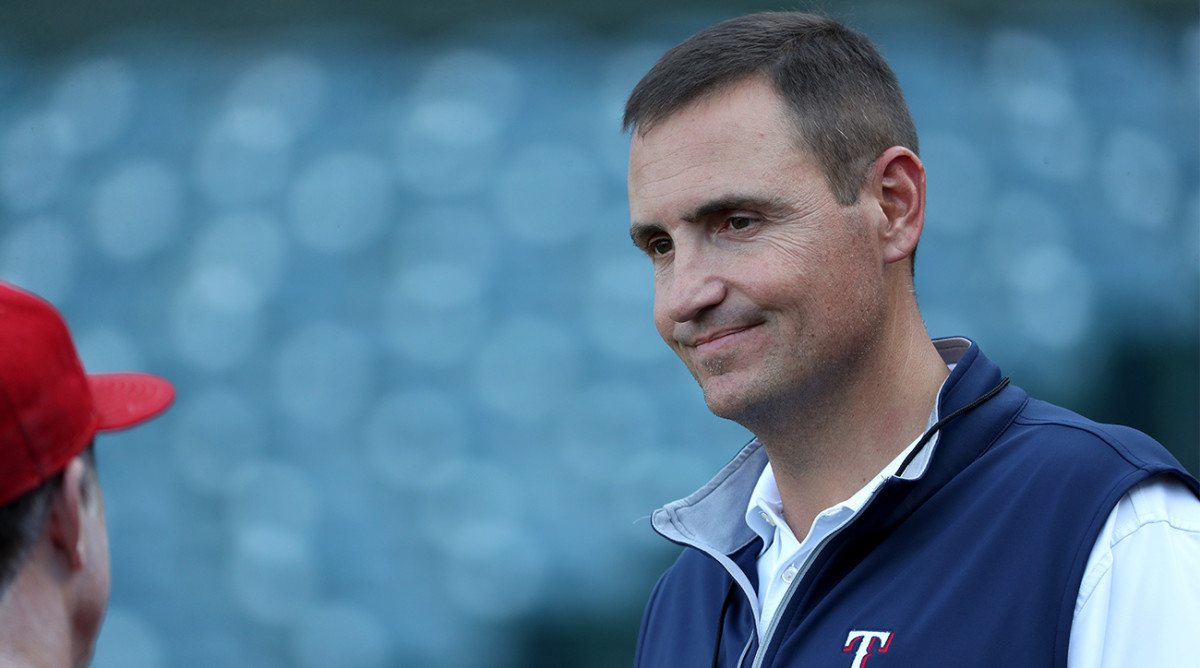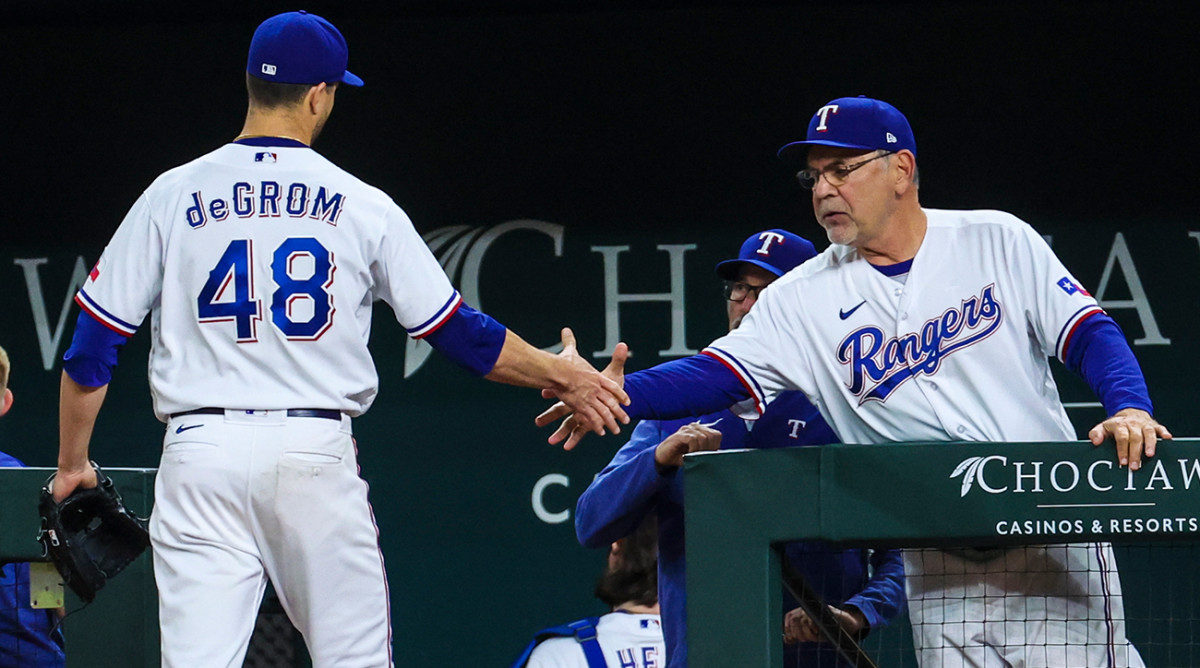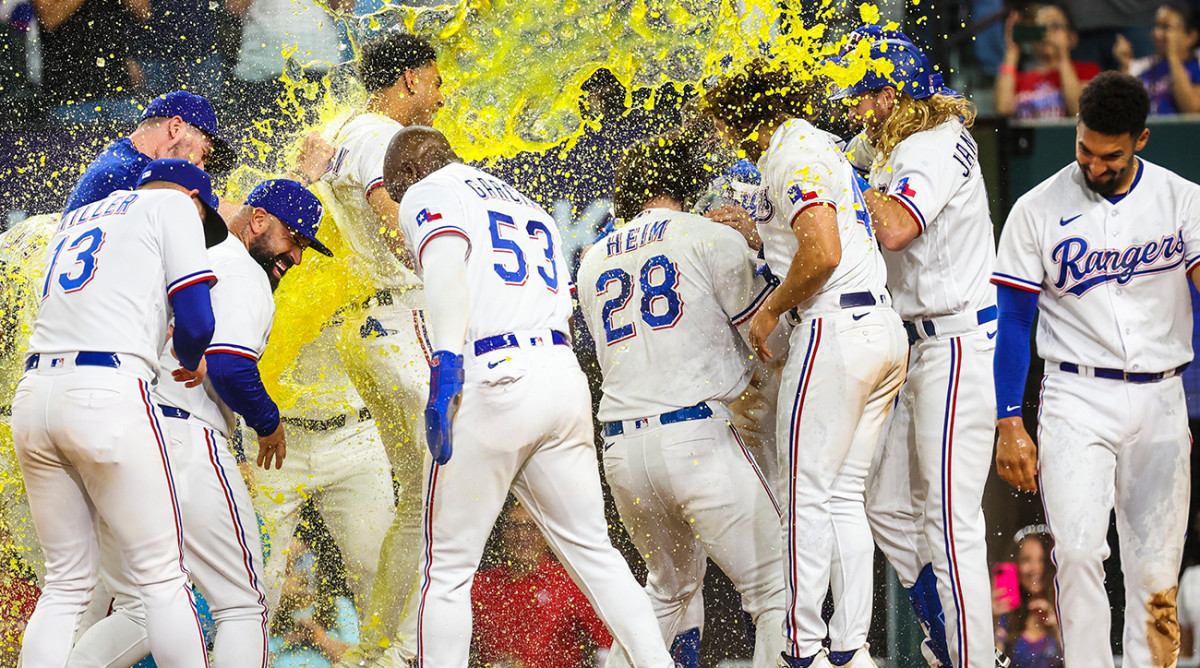Rangers Have the Ingredients to End Long Playoff Drought

The strings. You must notice the strings. If there was one tangible piece of evidence in spring training camp that best captured how Chris Young is going to rebuild the Rangers, it is those strings.
They are a pair of parallel, yellow strings strung tautly across the bottom of the strike zone in front of the home plates corresponding with the six-pack of bullpen mounds.
Such strings were once a staple of camps, no more famously than behind the clubhouse at Dodgers camp in Vero Beach, Fla., where everyone from Sandy Koufax to Fernando Valenzuela to Orel Hershiser learned to dot pitches at the lowest edges of the zone. Dodgers pitchers referred to it as sacred ground.
Like the hit-and-run, the art of bunting and the pitchout, the strings have largely disappeared in the analytically driven modern game. Teams encourage their pitchers to work up in the zone with more velocity. Texas has brought back the strings.
“That’s Mike Maddux,” says Texas general manager Young, referring to his new pitching coach. “He believes in order to work up you have to establish down, both with the breaking ball and the fastball.”

There is a string running through Young’s plan. This offseason Young, 43, hired Bruce Bochy, 67, as manager; Maddux, 61, as pitching coach; Dayton Moore, 56, and Ian Kinsler, 40, as advisers; Will Venable, 40, as associate manager; and Jacob deGrom, 34, Nathan Eovaldi, 33, Jake Odorizzi, 32, Martín Pérez, 31, and Andrew Heaney, 31, as starting pitchers. There is a balance between old-school values and new-school methods you might expect from someone like Young, who has a degree in politics from Princeton, where he was all-Ivy in basketball and baseball, who carved out a 13-year career on the mound despite not cracking 90 mph and who seemed to be a future commissioner candidate when in December 2020 the Rangers plucked him out of the MLB offices.
“To me it’s all about people and culture,” Young says. “I know how hard this game is. I know what the players go through. It’s very fresh for me. I feel like I’m not that far removed from the stresses, and I think they’ve only gotten bigger over the last several years. And so, I have great appreciation for what these guys have to do, the sacrifices they have to make, the demands on them.
“Our job as a front office is to give them every resource possible to realize their potential. And that starts with the people and culture. If there’s one thing that we want to dominate, that’s it.”
The push in recent years by most clubs is to try to dominate the technology side of the game—the Drivelining of baseball, in which you can never have too much technology and too many data scientists.
“It’s a great teaching tool,” Young says. “It’s a great way to get feedback. You can monitor and make changes. I wish I had that when I played. But it can’t be all that. There has to be balance. That’s probably the best way to describe it.”
A big part of that balance is hiring Moore, his general manager with the Royals, and listening to a team of advisers led by former players Kinsler, Michael Young, Nick Hundley, Darren Oliver and Colby Lewis. Texas might lead the majors in games played among front-office members.
“Part of the balance is to have guys who’ve lived it, who can give a baseball perspective,” Young says. “We have to have smart people that will challenge us to think in terms of being more innovative and understanding of what the trends and patterns in the game are that are showing they lead to success throughout the league. We want a balance of all of that.
“None of us have this figured out. I certainly don’t. We need the right collection of people to challenge each other daily. And then we hope that we’ll come to good conclusions when we have the right mix.”
There is surprising optimism around the Rangers for a team that lost 196 games the past two years while finishing a combined 73 games out of first place. The franchise has suffered six straight losing seasons for the first time since its inception as the Washington Senators in 1961 begat eight straight losing seasons. Last season Texas had the worst record in one-run games (15–35). Based on their runs scored and allowed, the Rangers should have been a 77–85 team. Instead, they were nine wins worse than their expected record.
Watch the Rangers with fuboTV. Start your free trial today.

That’s why Bochy was hired to replace Chris Woodward. He is a future Hall of Famer with three World Series championships and a .571 winning percentage in the postseason. Among those who have managed at least 40 postseason games, only Joe McCarthy, Sparky Anderson, Joe Torre and Casey Stengel are better in October.
“I think we needed a presence,” Young says. “We needed someone who could really create the environment we wanted—create a daily expectation of winning.
“And there was a believability to it. And I think that Boch certainly embodies that. And his track record speaks for itself. I got to play for him for one year. It was a great year. We made the playoffs. I absolutely loved him. I sort of held him on a pedestal because of that.
“But as I told him when we hired him, I wasn’t hiring him because I loved him when I played. I was hiring him because we feel like he is the right person to lead the Texas Rangers right now with where we are. And we spent a ton of time over the six- or eight-week period before we made the decision just really studying everything, identifying criteria and fleshing out what were the most important things that we needed in a manager. And I think it started with creating an environment both for our players and our staff and empowering them. We feel like in terms of talent, we’re accumulating the right talent. We’ve got a very good player development system with more talent on the way, but we have to have the right leadership in the dugout to reach that next level.”
The Rangers have committed $889.9 million to free agents the past two offseasons, primarily on infielders Corey Seager and Marcus Semien and deGrom. It’s the quickest way to turn around a franchise. It also is a way of curtailing what has long been a Rangers habit of rushing players to the big leagues too quickly.
“The way we accelerated is through free agency,” Young says, “so a young player can come into an environment where you have veterans around you —the right veterans around you—to teach you what winning looks like on a daily basis—showing up to the ballpark with a preparation, a focus and a routine all concentrated on winning that night’s game.
“It was so impactful to me as a player. I think for young players it can accelerate their development a little bit. I think it also takes a little bit of pressure off of them when they’re coming up, and they don’t have to hit third in the lineup. They can hit down in the order as they’re coming up and they don’t have to be at the top of the rotation.
“We’ve done a lot of background work on everybody we’ve signed and we know what they’re about as people and as competitors. So, I think that’s a big component to it.”
The people and culture may be where Young starts, but he knows the path forward this year for Texas is through its starting rotation. Over the past five seasons, Texas starters have ranked 29th, 25th, 24th, 28th and 25th in ERA. In addition to re-signing Pérez and adding deGrom, Eovaldi, Heaney and Odorizzi, the Rangers also have Jon Gray, 31. With the emphasis on experience, Young would be happy (and likely successful) if Texas breaks the record for most starts by pitchers 31 and older: 142 by the National League champion 1927 Pirates.

No player is more important to Young’s plan than deGrom. Texas signed deGrom to a five-year, $185 million contract. No other team was in that financial ballpark, including the Mets, who let a homegrown two-time Cy Young Award winner walk with nary a fight—while amassing the most expensive team in history. They held the line on deGrom and replaced him with Justin Verlander largely because of his injury history. deGrom made only 26 starts the past two seasons.
Besides studying deGrom’s medical records, the Rangers did a risk assessment of his biomechanics. They found similarities in his movement patterns with Verlander and Max Scherzer.
“While there is extreme power there, it’s not like he’s got huge mechanical flaws that he’s creating extreme power from and putting himself in a compromised position,” Young says. “From our standpoint, we felt good about the mechanics and pitchers like him with similar deliveries, who move in a similar fashion and their ability to age well.
“We did our homework. There are so many factors that go into the decision. There’s obviously the financial component. There’s the medical. There’s the R and D. There’s the biomechanical analysis that we did. There’s the teammate and there’s the personal side. I mean, we did a ton of background information, and he checked all the boxes in terms of our belief that for the next five years, he’s the type of pitcher that can sustain success given the way he does it, the way his body function works.
“We had to get comfortable with the injury history the last two years, obviously. But we have a very good team doctor. We have a very good medical group. And I think one of the things that was really neat in this was our head trainer when we were evaluating this saying, ‘We want this challenge. We believe that we can keep him healthy and we want this challenge.’
“And you know, we’re going to have moments where it doesn’t go our way. And that’s true with any pitcher, right? Especially if you get into age-34 through -39 seasons. But I think as we evaluated all of those aspects, we felt like this is someone that we would want to bet on.”
Thus far Texas has been thrilled with deGrom. He has the best pure stuff of any pitcher in baseball. He is a legit staff ace, although given his quiet demeanor not quite the prototypical staff leader. His leadership comes from his focus and work habits. One day on a backfield in spring training, for instance, playing catch with Odorizzi, deGrom made every throw with the care and concentration of someone trying to pitch out of a jam in a playoff game. Every throw he made, without exception, headed straight for the logo of Odorizzi’s cap.
“I thought it from afar,” Young says, “but now getting to watch him on a daily basis and seeing the way he really focuses with each pitch—the way he’s upset when he doesn’t hit the glove or when he doesn’t execute a pitch—it’s just a little bit different from everybody else. It’s fun to see him just go through his work, how intentional and deliberate he is with every single throw he makes.
“I have a great appreciation for it. I felt like I was pretty focused, but not to this level. I mean, it is really impressive just how in tune he is with his body and his mechanics, to be able to repeat his delivery and make an adjustment. It’s super impressive. But you know, that is the person he is. I really believe that he wants to be great, and he believes the best is still yet to come.”

The Rangers have a veteran rotation led by the best pitcher in baseball (when healthy). They have an offense that should benefit the most from the ban on shifts, especially Seager. Texas saw a shift 52% of the time last year. No other team faced the shift more than 44% of the time. The Rangers hit .260 on balls in play when they saw a shift and .314 when they didn’t.
The journey back to respectability—and maybe even to the playoffs—began with deGrom taking the ball against Philadelphia on Opening Day. (deGrom was pulled in the fourth inning after allowing an uncharacteristic five runs, but Texas still won 11–7.) The Rangers play 15 of their first 24 games against the Cubs, Royals, A’s and Reds. The schedule lines up for a fast start.
Having spent money, leaned into experience and done its homework, Texas has an opportunity to be the biggest surprise of the season. More than the best of Young’s plans, however, that opportunity will ride on deGrom’s staying healthy.
